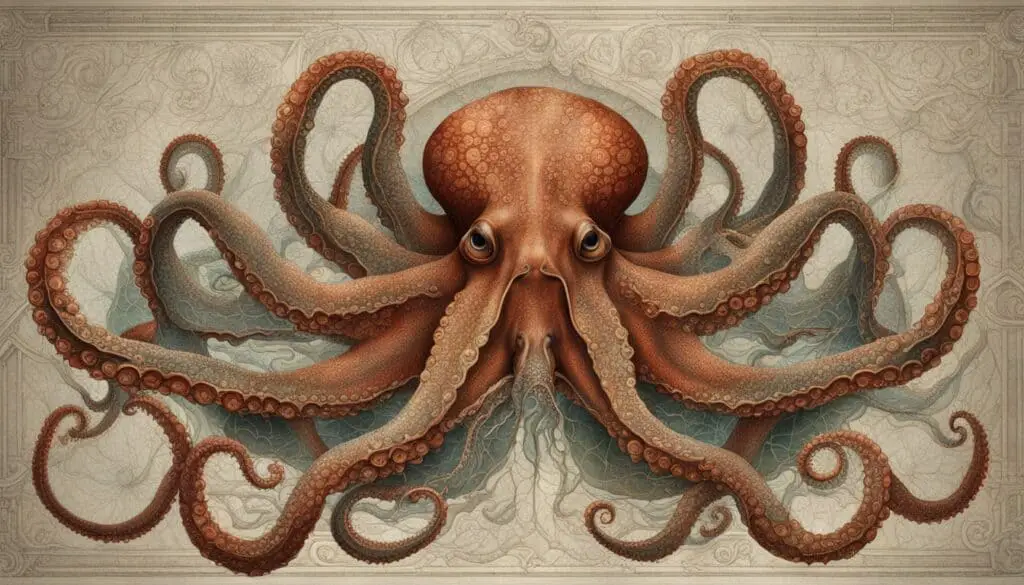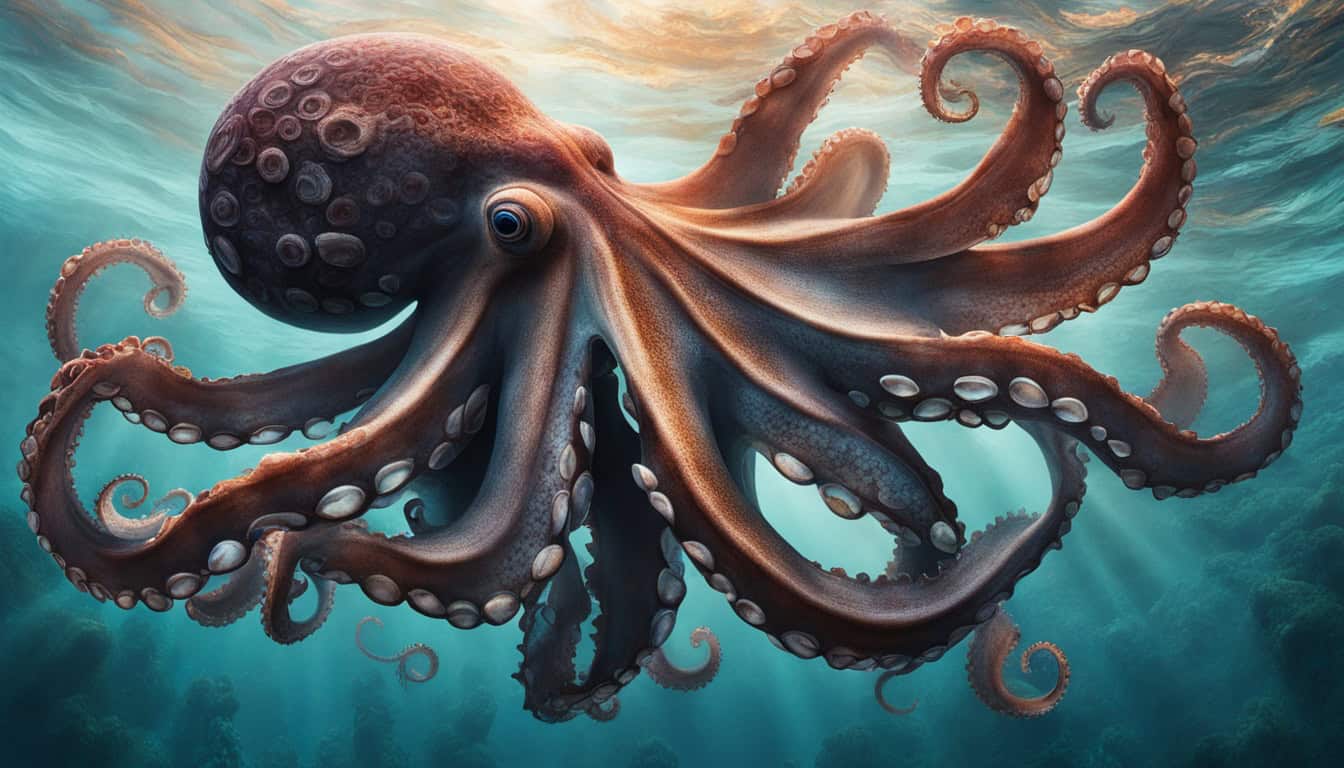The octopus is a fascinating creature known for its bright colors and smartness. It has a special circulatory system with three hearts. This makes you wonder: how many hearts does an octopus have? Learning about this can help us understand more about octopus biology and their life underwater. We will look into the anatomy of octopuses, focusing on their heart systems and structure.
The Fascinating Biology of Octopuses
Octopuses are part of a group called cephalopods, which also includes squids and cuttlefish. They have special features that help them live in different ocean environments. These features make their biology truly unique.
They have soft, flexible bodies and eight arms with suckers. These suckers help them move and handle objects. This makes them very skilled at getting around and solving problems.
The cephalopod anatomy of octopuses is quite complex. They have a central brain and nerves in each arm. This setup lets them move and think in ways that are very smart for creatures without a backbone.
Octopuses have special organs that help them survive. They have gills for breathing underwater and can change color to hide from predators. This ability to change color is one of the most amazing things about them.
Octopuses are truly unique creatures. Learning about their biology shows us how diverse and complex life can be under the sea. It also helps us understand their role in the ocean ecosystem.
How Many Hearts Does an Octopus Have?
Octopuses have a special anatomy that helps them survive underwater. You might ask, how many hearts do they have? They have three hearts, which is quite unique. This setup lets them live in their ocean homes.
Understanding the Three-Heart System
An octopus has three hearts, each with a different job. Two hearts pump blood to the gills, where it gets oxygen. This is key for the octopus to stay energetic.
The third heart sends oxygen-rich blood to the rest of the body. It makes sure all organs and muscles get enough oxygen.
The Role of Each Heart in Circulation
Every heart in the octopus’s system is vital. The branchial hearts keep blood flowing and picking up oxygen. Then, the systemic heart spreads this oxygen to the octopus’s body.
This complex system is needed for the octopus’s active life. Without it, they wouldn’t be able to survive.
Octopus Heart Facts
Octopuses have a unique heart structure that shows how well they adapt to life in the water. They have three hearts, each with a special job to keep them moving and active.
Why Octopuses Need Three Hearts
Octopuses need three hearts because their blood is blue and carries oxygen differently. Their blood uses haemocyanin, which is not as good at carrying oxygen as the blood in most other animals. So, they need more hearts to get enough oxygen for their busy lives and hunting.
Comparison with Other Animals
Octopuses are different from most animals, which usually have just one heart. This single heart is enough for them because their blood is better at carrying oxygen. Octopuses, with their complex heart system, show how well they’ve adapted to living in the ocean. Here’s a quick look at how different animals compare:
| Animal Type | Number of Hearts | Blood Type | Oxygen Transport Molecule |
|---|---|---|---|
| Octopus | 3 | Blue | Haemocyanin |
| Mammals | 1 | Red | Hemoglobin |
| Fish | 1 | Red | Hemoglobin |
| Earthworm | 5 | Red | Hemoglobin |

Insights into Octopus Anatomy
The world of octopus anatomy is truly fascinating. Octopuses don’t have a rigid skeleton like many other sea creatures. This lets them move through tight spots with great flexibility.
Their circulatory system is key to their active life. They have three hearts. Two pump blood to the gills, and the third sends it to the rest of their body. This setup makes sure they get enough oxygen for their complex behaviors and fast movements.
Octopuses also have a lot of neurons in their arms. These neurons help them be very skilled and solve problems. Their anatomy shows how adaptable and smart they are, making them successful in the sea.
The Unique Cephalopod Cardiovascular System
Octopuses have a special way of surviving in the ocean. They use haemocyanin, a copper-based protein, for carrying oxygen. This is different from the iron-based hemoglobin used by many other animals.
This special protein helps them in cold waters and places with low oxygen. It makes them better at surviving in tough conditions.
Haemocyanin vs. Hemoglobin
Haemocyanin and hemoglobin are both important for the octopus’s heart. Hemoglobin works well in warm, oxygen-rich places. But haemocyanin is better in the cold depths of the ocean.
Using haemocyanin lets octopuses live in harsh conditions. This is key for their active life and hunting ways.
How the Circulatory System Supports Their Lifestyle
The octopus’s heart is designed for their busy life. It has three hearts that work together. This helps them move fast, avoid predators, and explore the ocean floor.
Haemocyanin is key to delivering oxygen to muscles and organs. It also helps them adapt to changing ocean conditions. This shows how amazing these creatures have evolved.
FAQ
How many hearts does an octopus have?
An octopus has a special three-heart system. It includes two branchial hearts and one central systemic heart.
What is the function of the octopus heart?
The two branchial hearts send deoxygenated blood to the gills for oxygen. The central systemic heart sends oxygen-rich blood all over the body.
Why do octopuses have more than one heart?
Octopuses have multiple hearts for more pumping power. Their blue blood uses haemocyanin, which is less good at carrying oxygen than the hemoglobin in vertebrates.
How does the octopus circulatory system differ from that of vertebrates?
Octopuses have three hearts, unlike vertebrates with one. They use haemocyanin for oxygen transport, making their circulatory system unique.
How do octopuses use their circulatory system to support their active lifestyle?
The octopus’s circulatory system makes sure their muscles and organs get enough oxygen. This helps them hunt, avoid predators, and move through complex underwater spaces.
What is haemocyanin and how does it benefit octopuses?
Haemocyanin is a copper-based protein in octopus blood. It works better in low-oxygen places, helping octopuses live in different marine habitats.
How does octopus anatomy contribute to its survival?
The octopus’s flexible body and special organs, along with their unique circulatory system, make them adaptable. This helps them solve problems in various marine environments.







